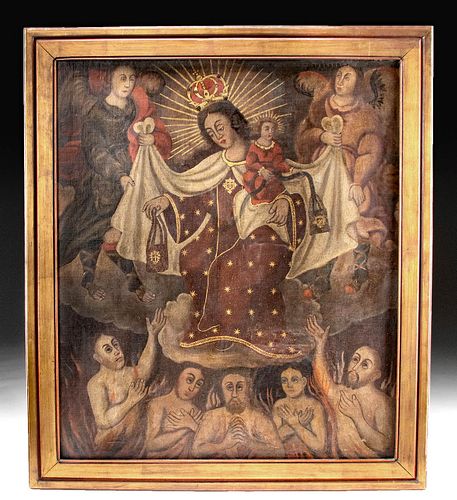Large 19th C. Mexican Painting, Scapular of Our Lady
Lot 312
About Seller
Artemis Fine Arts
686 S Taylor Ave, Ste 106
Louisville, CO 80027
United States
Selling antiquities, ancient and ethnographic art online since 1993, Artemis Gallery specializes in Classical Antiquities (Egyptian, Greek, Roman, Near Eastern), Asian, Pre-Columbian, African / Tribal / Oceanographic art. Our extensive inventory includes pottery, stone, metal, wood, glass and textil...Read more
Estimate:
$2,600 - $3,900
Absentee vs Live bid
Two ways to bid:
- Leave a max absentee bid and the platform will bid on your behalf up to your maximum bid during the live auction.
- Bid live during the auction and your bids will be submitted real-time to the auctioneer.
Bid Increments
| Price | Bid Increment |
|---|---|
| $0 | $25 |
| $300 | $50 |
| $1,000 | $100 |
| $2,000 | $250 |
| $5,000 | $500 |
| $10,000 | $1,000 |
| $20,000 | $2,500 |
| $50,000 | $5,000 |
| $100,000 | $10,000 |
| $200,000 | $20,000 |
About Auction
By Artemis Fine Arts
Jul 22, 2021
Set Reminder
2021-07-22 10:00:00
2021-07-22 10:00:00
America/New_York
Bidsquare
Bidsquare : Summer Antiquities & Ethnographic Art Auction
https://www.bidsquare.com/auctions/artemis-gallery/summer-antiquities-ethnographic-art-auction-7245
Travel around the world and back in time...and be amazed at the treasures you will find! Antiquities from Egypt, Greece, Italy and the Near East, Asian, Pre-Columbian, African / Tribal / Oceanic, Native American, Spanish Colonial, Russian Icons, Fossils, Fine Art, much more! Artemis Fine Arts info@artemisgallery.com
Travel around the world and back in time...and be amazed at the treasures you will find! Antiquities from Egypt, Greece, Italy and the Near East, Asian, Pre-Columbian, African / Tribal / Oceanic, Native American, Spanish Colonial, Russian Icons, Fossils, Fine Art, much more! Artemis Fine Arts info@artemisgallery.com
- Lot Description
Latin America, Mexico, ca. 19th century CE. A large painting on canvas depicting the Blessed Virgin Mary in her role as the patroness of the Carmelite Order or the Discalced Carmelite Order - also known as the Scapular of Our Lady of Mount Carmel or the Brown Scapular. N.S. de Carmen is presented in her role as the protectress, donning her traditional robes painted jewel tone red with 8-pointed stars, decorative trim, and the shield of the Carmelite Order delineated in gold leaf. She holds the Christ Child and is flanked by two angels who hold up her white mantle of cascading, voluminous folds. Below are 5 souls in purgatory. An elegantly balanced composition with skillfully modeled figures framed in a sizeable, gold and red painted wood frame. Size: painting itself measures 45" L x 38.375" W (114.3 cm x 97.5 cm); 51.5" L x 44.75" W (130.8 cm x 113.7 cm) in frame
Both Our Lady of Mount Carmel and the Child hold scapulars that resemble the shield of the Carmelite Order comprised of the cross on a mound with stars on either side. This shield and the colors of her robe and cape identify the figure as N.S. de Carmen. Mary's dark complexion, brunette hair, and elaborate golden collar and crown are characteristic of Mexican interpretations. The feast day of Our Lady of Mount Carmel associated with the Scapular is celebrated on July 16th.
According to the Congregation for Divine Worship and the Discipline of the Sacraments; Directory on Popular Piety and the Liturgy. Principles and Guidelines. Vatican, 2001, the Brown Scapular is "an external sign of the filial relationship established between the Blessed Virgin Mary, Mother and Queen of Mount Carmel, and the faithful who entrust themselves totally to her protection, who have recourse to her maternal intercession, who are mindful of the primacy of the spiritual life and the need for prayer."
The scapular was traditionally a broad band of cloth worn over the shoulders, that fell below the knees toward the feet front and back as an apron. It is still worn as a component of the religious habit by a number of orders of monks and friars. Gradually the scapular was adapted for use by the laity, and became two small panels of brown cloth joined by strings and worn over the shoulders as a familiar Marian sacramental. Its popularity persisted because of its association with the salvation of souls.
Provenance: ex-private Moore collection, Denver, Colorado, USA, acquired prior to 1990
All items legal to buy/sell under U.S. Statute covering cultural patrimony Code 2600, CHAPTER 14, and are guaranteed to be as described or your money back.
A Certificate of Authenticity will accompany all winning bids.
PLEASE NOTE: Due to recent increases of shipments being seized by Australian & German customs (even for items with pre-UNESCO provenance), we will no longer ship most antiquities and ancient Chinese art to Australia & Germany. For categories of items that are acceptable to ship to Australia, please contact us directly or work with your local customs brokerage firm.
#122003Areas of restoration corresponding with repaired canvas visible on verso. One small pierced hole remaining. Marvelous original stretchers. Some metal hooks from previous suspension. Painting shows signs of age, but imagery quite vivid. Frame with minor paint loss and a few old nicks, but overall excellent.Condition
- Shipping Info
-
All shipping is handled in-house for your convenience. Your invoice from Artemis Gallery will include shipping calculation instructions. If in doubt, please inquire BEFORE bidding for estimated shipping costs for individual items.
-
- Buyer's Premium



 EUR
EUR CAD
CAD AUD
AUD GBP
GBP MXN
MXN HKD
HKD CNY
CNY MYR
MYR SEK
SEK SGD
SGD CHF
CHF THB
THB














